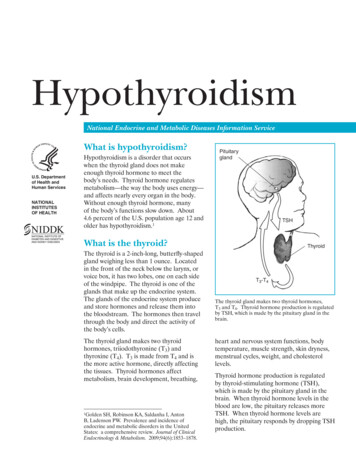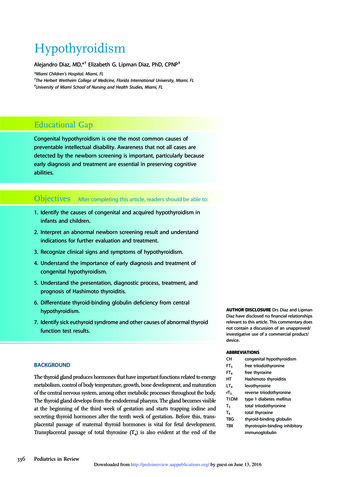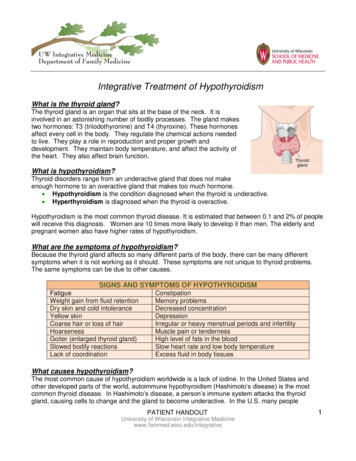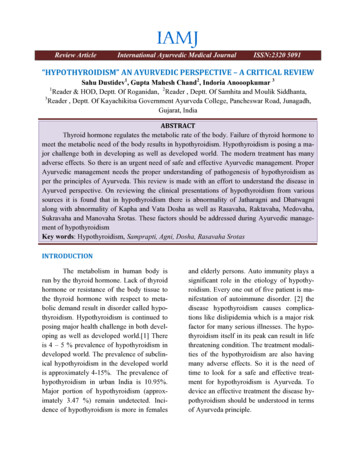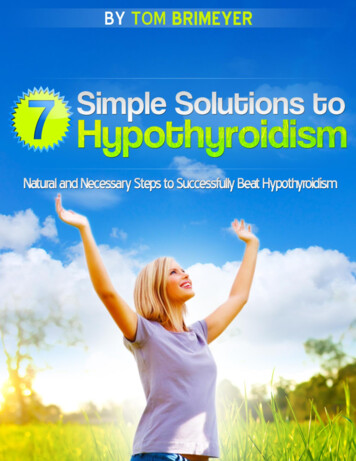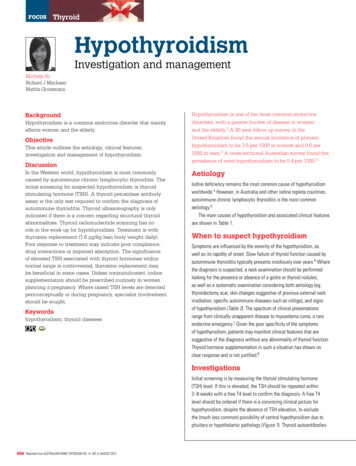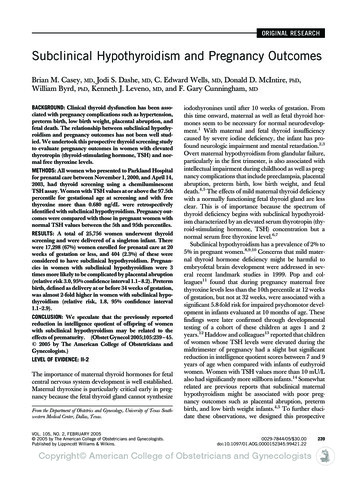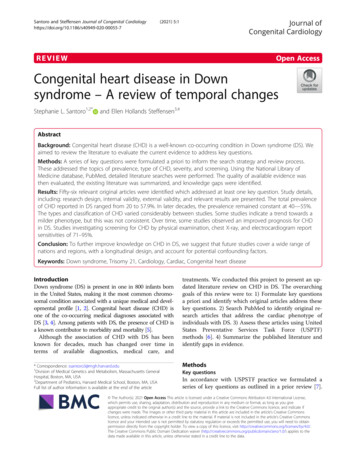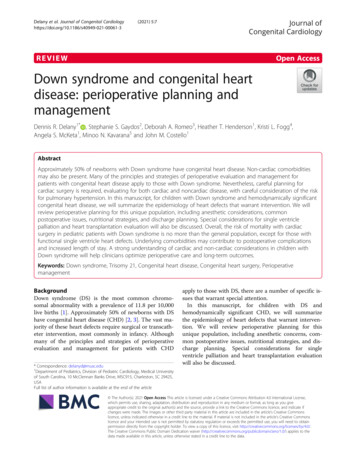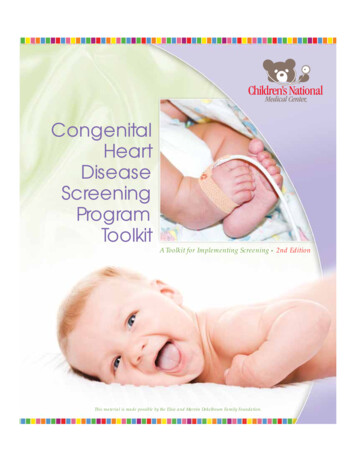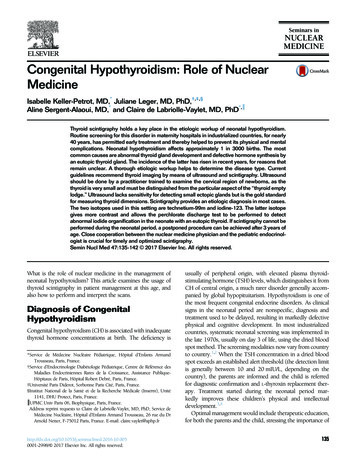
Transcription
Congenital Hypothyroidism: Role of NuclearMedicineIsabelle Keller-Petrot, MD,* Juliane Leger, MD, PhD,†,‡,§Aline Sergent-Alaoui, MD,* and Claire de Labriolle-Vaylet, MD, PhD*, Thyroid scintigraphy holds a key place in the etiologic workup of neonatal hypothyroidism.Routine screening for this disorder in maternity hospitals in industrialized countries, for nearly40 years, has permitted early treatment and thereby helped to prevent its physical and mentalcomplications. Neonatal hypothyroidism affects approximately 1 in 3000 births. The mostcommon causes are abnormal thyroid gland development and defective hormone synthesis byan eutopic thyroid gland. The incidence of the latter has risen in recent years, for reasons thatremain unclear. A thorough etiologic workup helps to determine the disease type. Currentguidelines recommend thyroid imaging by means of ultrasound and scintigraphy. Ultrasoundshould be done by a practitioner trained to examine the cervical region of newborns, as thethyroid is very small and must be distinguished from the particular aspect of the “thyroid emptylodge.” Ultrasound lacks sensitivity for detecting small ectopic glands but is the gold standardfor measuring thyroid dimensions. Scintigraphy provides an etiologic diagnosis in most cases.The two isotopes used in this setting are technetium-99m and iodine-123. The latter isotopegives more contrast and allows the perchlorate discharge test to be performed to detectabnormal iodide organification in the neonate with an eutopic thyroid. If scintigraphy cannot beperformed during the neonatal period, a postponed procedure can be achieved after 3 years ofage. Close cooperation between the nuclear medicine physician and the pediatric endocrinologist is crucial for timely and optimized scintigraphy.Semin Nucl Med 47:135-142 C 2017 Elsevier Inc. All rights reserved.What is the role of nuclear medicine in the management ofneonatal hypothyroidism? This article examines the usage ofthyroid scintigraphy in patient management at this age, andalso how to perform and interpret the scans.Diagnosis of CongenitalHypothyroidismCongenital hypothyroidism (CH) is associated with inadequatethyroid hormone concentrations at birth. The deficiency is*Service de Médecine Nucléaire Pédiatrique, Hôpital d’Enfants ArmandTrousseau, Paris, France.†Service d’Endocrinologie Diabétologie Pédiatrique, Centre de Référence desMaladies Endocriniennes Rares de la Croissance, Assistance PubliqueHôpitaux de Paris, Hôpital Robert Debré, Paris, France.‡Université Paris Diderot, Sorbonne Paris Cité, Paris, France.§Institut National de la Santé et de la Recherche Médicale (Inserm), Unité1141, DHU Protect, Paris, France. UPMC Univ Paris 06, Biophysique, Paris, France.Address reprint requests to Claire de Labriolle-Vaylet, MD, PhD, Service deMédecine Nucléaire, Hôpital d’Enfants Armand Trousseau, 26 rue du DrArnold Netter, F-75012 Paris, France. E-mail: emnuclmed.2016.10.0050001-2998/& 2017 Elsevier Inc. All rights reserved.usually of peripheral origin, with elevated plasma thyroidstimulating hormone (TSH) levels, which distinguishes it fromCH of central origin, a much rarer disorder generally accompanied by global hypopituitarism. Hypothyroidism is one ofthe most frequent congenital endocrine disorders. As clinicalsigns in the neonatal period are nonspecific, diagnosis andtreatment used to be delayed, resulting in markedly defectivephysical and cognitive development. In most industrializedcountries, systematic neonatal screening was implemented inthe late 1970s, usually on day 3 of life, using the dried bloodspot method. The screening modalities now vary from countryto country.1,2 When the TSH concentration in a dried bloodspot exceeds an established alert threshold (the detection limitis generally between 10 and 20 mIU/L, depending on thecountry), the parents are informed and the child is referredfor diagnostic confirmation and L-thyroxin replacement therapy. Treatment started during the neonatal period markedly improves these children’s physical and intellectualdevelopment.3,4Optimal management would include therapeutic education,for both the parents and the child, stressing the importance of135
136regular treatment and the criteria used to judge treatmentbalance. Regular medical evaluation of thyroid function isnecessary, with L-thyroxin dose adjustment if required, as wellas regular assessment of the child’s physical and mentaldevelopment, particularly when the CH is initially severe.3French cohort studies on the outcome of patients with CHshow that school performance is broadly comparable to that ofhealthy controls, with the same average age of graduationwhen treatment is well conducted.5 However, despite treatment, these children tend to be more overweight, to have morehearing or visual disorders in adulthood, and to be less wellsocially integrated, especially when the CH is initially severe.6Routine neonatal screening has transformed the prognosisof this disease, which is a major scientific and human successstory. Screening has also been shown to be cost-effective7 but,unfortunately, it is not yet performed in every country. Onelimitation is that TSH-based screening, used in most countries,cannot identify rare forms of central (pituitary) hypothyroidism, contrary to T4 assay.EtiologiesThe most common cause of CH is thyroid dysgenesis, that is tosay defective thyroid development. In most such cases, thethyroid tissue is present in the form of a nodule locatedbetween the base of the tongue and the base of the neck,following failed physiological migration of the thyroid budduring embryogenesis (ectopia). Slightly less frequently, thereis a complete lack of thyroid tissue (athyreosis). More rarely,atrophic thyroid tissue is found in the thyroid lodge (hypoplasia or hemithyroidism).8The other cause of CH is abnormal hormone production(dyshormonogenesis).9,10 In this case, the thyroid is present, inthe normal position (eutopic thyroid), with or without goiter,but it is nonfunctional. Dyshormonogenesis is due to mutations in genes involved in thyroid hormone synthesis. Thesemutations can affect iodide uptake by the sodium-iodidesymporter (NIS), passive iodide transport (PDS or Pendrin),iodide organification (TPO, DUOX2, and DUOXA2), thyroglobulin synthesis, or iodide recycling.8,11,12When the thyroid is present, without hypoplasia, CH maybe either permanent or transient (in 30% of cases).9,13 Themost frequent causes of transient CH are iodine deficiency oriodine overload in the mother, placental transfer of blockingantibodies or antithyroid drugs (in case of maternal thyroiddisease), and some genetic defects (eg, compound heterozygous DUOX2 gene mutations).14-16 At birth, when historytaking does not point toward a specific cause, it is often difficultto predict the permanent or transient nature of CH. Treatmentwith L-thyroxine must thus be started rapidly, and the situationreassessed at a later date.3,17-19IncidenceThe incidence of CH varies by country and iodine status. Thereis also an ethnic component. Thus, within the state ofCalifornia, the incidence is higher in Indian populationsI. Keller-Petrot et al.(1/1200 births), followed by Hispanics (1/1600 births),Chinese and Vietnamese (1/2380 births), non-Hispanic whites(1/3533 births), and African Americans (1/11,000 births).20The distribution of the different etiologies also varies widelyaccording to the country and diagnostic method.21 In France,patients are included in a national registry. During the period1982-2012, 6622 cases of CH were diagnosed among23,669,598 newborns tested nationwide, for an incidence of1 per 3574 births. Dysgenesis was present in 71% of cases,whereas the thyroid was present in the remaining 29%. TheFrench database confirms that the incidence of CH is rising byapproximately 5% per year, as reported in other countries.22This increase has received no clear explanation; it is not linkedto a lowering of the alert threshold, contrary to somesuggestions.23-26Importance of Early EtiologicDiagnosisIt is very important to determine the etiology of CH at the timeof diagnosis, even though initial treatment is always the same.Indeed, parents are very upset to discover their child has acongenital disease. When the thyroid gland is in place, theyhope their child will be among the 30% in whom thehypothyroidism is transient. Visual confirmation of athyreosisor ectopia helps them come to terms with the need for lifelongdaily treatment. Parents also raise questions about the risk ofrecurrence in subsequent pregnancies. Accurate etiologicdiagnosis provides the answer: dysgenesis is mainly sporadic27;familial forms represent only 2% of cases28; and dyshormonogenesis often has a genetic component with autosomalrecessive transmission in most cases.11,12What Imaging Modalities forInitial Assessment of NeonatalCH?The Rome consensus conference, held under the auspices ofthe European Society of Paediatric Endocrinology (ESPE) andattended by representatives of Pediatric Endocrinology societies around the world, resulted in the publication of ConsensusGuidelines on Screening, Diagnosis, and Management of Congenital Hypothyroidism in 2014.3At the time of initial diagnosis, recommended examinationsinclude radiography of the knees plus thyroid ultrasound andscintigraphy.29 Absent femoral and tibial epiphyseal nucleireflect the severity of intrauterine hypothyroidism, which is amajor determinant of the subsequent prognosis.5,6,30 Theadvantages of combining ultrasound and scintigraphy forthyroid exploration are that both high-resolution morphological (ultrasound) and functional (scintigraphy) information isobtained. Each technique compensates for the limitations ofthe other.21,31,32Thyroid ultrasound examination is delicate in the neonatalperiod, as the normal thyroid is very small, with a volumegenerally between 0.5 and 4 mL.33 However, ultrasound can
Congenital hypothyroidismreveal the presence of the thyroid gland, with or withoutgoiter. The different forms of dysgenesis are distinguished byanalysis of the thyroid lodge first and then the thyroglossalduct. Normal thyroid tissue is more echogenic than muscleand less echogenic than fat. Detection of an empty thyroidlodge can be complicated by the presence of small hyperechoic structures on either side of the trachea, thymic tissue(hypoechoic), or cysts located in the thyroid lodge.29,34 Theseartefacts can be identified by an experienced practitioner but,even with the use of color Doppler, ultrasound is informativein only one in three newborns with thyroid ectopia,35 whichis only visible if the thyroid tissue is organized into asufficiently large nodule. The strengths of ultrasound includedetection of a normally located thyroid gland, the uniqueability to accurately measure thyroid volume, and the abilityto “correct” scintigraphic false-negatives.Scintigraphy remains the gold standard for the workup ofCH, particularly when seeking a developmental abnormality(ectopia or athyreosis). Iodine-123 or technetium-99m uptakeby thyroid cells enables them to be located, provided theexamination is done before or during the first week ofreplacement therapy. Beyond this window, especially if theinitial TSH is moderately high, radioactive iodine uptake bythyroid tissue, which is under the control of TSH, may bealmost zero.When etiologic studies are not performed at birth, scintigraphy should be done after the age of 3 years, when treatmentinterruption no longer poses a risk (the critical period ofneurocognitive development has passed).3 Some authorsrecommend the use of recombinant TSH to avoid hormonewithdrawal.36Thyroid Scintigraphy inNewborns With CH: PracticalConsiderations137contrast is better and poorly functional thyroid tissue such assmall ectopias can be visualized.8 Iodine-123 has the addedadvantage of allowing a perchlorate discharge test when thethyroid is present.8,38Radiopharmaceutical AdministrationThe chosen radiopharmaceutical is injected intravenously, atan activity of 0.03 mCi (1.1 MBq) for iodine-123 or 0.110.22 mCi (4-8 MBq) for technetium-99m-pertechnetate. Paincan be minimized by breast or bottle feeding, or by using apacifier dipped in 30% glucose. Iodine-123 can be administered orally if the intravenous route is unavailable. Thedisadvantages of oral administration are a higher risk ofcontamination with saliva or vomit.Image AcquisitionThe images are acquired after 15 minutes with technetium99m or after 1 hour with iodine-123. Restraints used at thisearly age must be gentle. It is not easy to keep the head inextension if the child is not asleep. One solution is to use amattress specially designed to restrain newborns (Fig. 1).Anterior acquisitions of the trunk are made for 5 minutes,with a low-energy high-resolution collimator and a 128 128matrix. Given the small size of newborns, the whole body isdisplayed on a single field. Complementary acquisitions (pinhole or profile) depend on the results of the anterior image.InterpretationWhen the thyroid is present, the two lobes are visualized at thebase of the neck. The salivary glands and stomach secrete theisotope because their cells express the iodide (and technetium99m) transporter (NIS). The bladder is also visible because theradiopharmaceuticals are eliminated in urine (Fig. 2). The twolobes appear symmetric in the normal thyroid. The apparentOrganization of the Scintigraphy AppointmentScintigraphy should never be allowed to delay treatmentinitiation. The fact that scintigraphy must be done less than aweek after the beginning of L-thyroxine therapy means thatgood coordination between the pediatric endocrinologist andnuclear medicine department is crucial. The request forscintigraphy must be made to the nuclear medicine department as soon as the endocrinologist has seen the family toinitiate treatment. The nuclear medicine department then has afew working days to do the scan, which must be considered apriority.Choice of IsotopeTechnetium-99m and iodine-123 are both captured by NISlocated at the basal pole of thyroid cells, and both isotopes aresuitable for imaging. Technetium is cheaper and thereforepreferred in many countries, but the image is of lower qualitythan with iodine-12337: the signal-to-noise ratio is low, and theimage only reflects NIS expression. Iodine-123 gives a highersignal-to-noise ratio because of the organification process;Figure 1 Contention mattress for newborns. The child’s head ismaintained on both sides. (Color version of figure is available online.)
I. Keller-Petrot et al.138size of the scintigraphic image depends primarily on theintensity of tracer uptake.In case of hypoplasia, the thyroid is located in its lodge buthas an abnormal, asymmetric morphology that is more visibleon images obtained with a pinhole collimator: atrophy of onelobe may be seen (Fig. 3), or hemiagenesis, most frequently onthe left.21 Tracer uptake is often low in this case, andsonographic findings usefully complement the scintigraphicresults.In case of ectopia, a circular focus of tracer accumulation isseen, and the lateral view confirms its position, usually at thebase of the tongue (Fig. 4). This small focus can be difficult todistinguish from salivary activity when technetium-99m isused.38 Rinsing the mouth by making the neonate drink canavoid this source of error. Dual ectopia is infrequent. Not allectopias are diagnosed in the neonatal period, because in rarecases hormone production is sufficient for the child to beeuthyroid at birth.39When the thyroid is not visible on the scintigraphic imageacquired 1 hour after intravenous injection, later acquisitionsmust be done (3 hours postinfusion with iodine-123) beforediagnosing athyreosis (Fig. 5). Ultrasound findings can revealrare false-negative scintigraphic results by showing the thyroidin its lodge whereas no isotope uptake is visible. The mainavoidable cause of such false-negatives is scintigraphic examination after more than 7 days of replacement therapy,especially when the initial TSH is not very high. Maternalanti–TSH receptor blocking antibodies, in a context ofmaternal autoimmune thyroid disease, can also prevent traceruptake despite the presence of the thyroid gland.40 NeonatalCH is transient is such cases. In addition, very rare neonateswith an intact thyroid are deficient in NIS.41 The lack ofsalivary and gastric tracer activity should point to this cause ofnegative thyroid uptake. Palpation and ultrasound reveal thepresence of a goiter. Finally, inactivating mutations of the TSHreceptor gene27,42 can lead to little or no tracer uptake8 even ifthe gland is present and is normal sized or hypoplastic.With technetium-99m, the examination is consideredcomplete once the acquisitions have been made. Neonateswith CH with an normal thyroid are considered to havedyshormonogenesis, but their organification status cannot bedetermined in countries where iodine-123 is unavailable.When iodine-123 uptake reveals an eutopic thyroid, without hypoplasia, the perchlorate discharge test is indicated.The Perchlorate Discharge TestIn normal conditions, iodide captured at the basal pole by NISis quickly transported to the apical pole of thyrocytes, where itis fixed (organified) to thyroglobulin tyrosine residues, leavingno free iodide in the thyrocyte. By contrast, iodide accumulatesin the thyrocytes if organification is defective. In this case,sodium perchlorate, which is also captured by thyroid cells butnot organified, competes with iodide and chase it out ofthe cells.The effect of sodium perchlorate (Irenat, Bayer) is evaluatedby measuring thyroid activity before and 1 hour after itsadministration. The dosage for a newborn is 90 mg (0.3 mL).Figure 2 Scintigraphic aspect of the intact thyroid. Left: after iodine-123 injection; right: after injection of 6 MBq of Tc-99m(Courtesy: Dr I Roca). With the latter isotope, salivary activity present in the mouth can mask a small ectopic gland, and theacquisition should be repeated after giving the child a drink if the thyroid is not initially visible.
Congenital hypothyroidism139Figure 3 Hypoplasia. Anterior view (left) and pinhole magnification (right): the thyroid is in place but the right lobe ishypoplastic.In the normal neonate, perchlorate does not alter thyroidactivity and the test is therefore negative. In contrast, thyroidactivity is reduced when organification is defective, and the testis then positive. The change in activity is measured as the ratiobetween the differences in the activity of the thyroid region ofinterest (ROI) (corrected for background noise) before andafter perchlorate, and the initial activity (also corrected forbackground noise). For accurate measurement of thyroidactivity, the images must be acquired in identical geometricconditions, particularly the distance between the child’s neckand the collimator. Subtraction of the background noise oneach image is crucial, because iodine-123 recirculationincreases the background noise. The background noise ROI,identical in size to the thyroid ROI, is placed in the right lungfield to avoid radiation emitted by the thyroid and stomach. Asample calculation is shown in Figure 6. A change of 10% isconsidered significant.43 It can reach 98% in children with noiodide organification (Fig. 7).Defective organification is usually permanent, being becauseof a defect in a gene involved in organification (the TPO andDUOX2/DUOXA2 genes in 470% of cases).21,44 It can also betransient, however, following iodine overload due to polyvindione disinfection before maternal surgery (eg, cesarean).21Some organification disorders, especially those related toDUOX2/DUOXA2 gene defects may also be transient. Reevaluation of thyroid function is thus recommended in allFigure 4 Ectopia. Front and profile views: the ectopic gland is located at the base of the tongue.
I. Keller-Petrot et al.140The perchlorate test is normal in case of impaired thyroglobulin synthesis or secretion.46The pediatric nuclear medicine department of ArmandTrousseau Children’s Hospital in Paris studied 182 consecutivenewborns referred for CH between 2005 and 2008.47 Thethyroid was eutopic in 43% of cases (77 children), whotherefore underwent the perchlorate test. The result waspositive in 42 of 77 cases (55%), with more than a 70%reduction in thyroid activity in 13 of 77 cases (17%). Thesechildren with severe organification disorders, like those withathyreosis (21% of children in our study), have some of themost severe forms of CH. These children require close medicalmonitoring and very fine dose adjustment.Dosimetry in Neonatal ThyroidScintigraphyFigure 5 Athyreosis. Image acquired 3 hours after IV injection ofiodine-123. Note the gastric activity and urinary activity (in thediaper). IV, intravenous.forms of hypothyroidism associated with an eutopic thyroidgland. In a French study of 71 neonates with CH with apositive result for perchlorate test, CH was transient in 11cases. Only one of the 11 children had a discharge test showinga change exceeding 90%.45When technetium-99m-pertechnetate is used, its activity is0.16 mCi (6 MBq). An activity of 0.03 mCi (1.1 MBq) ofiodine-123 is sufficient, although the Paediatric Dosage Cardrecommends a minimum of 0.08 mCi (3 MBq).48 In theseconditions, the effective dose is 0.12 rems (1.2 mSv) withtechnetium-99m and 0.36 rems (3.6 mSv) with iodine-123.This effective dose (the same as natural background radiationin many countries) is probably on the high side,8 being basedon the assumption of an eutopic thyroid fixing 30% of theinjected activity. It is not valid in case of athyreosis or scarceectopic thyroid tissue. When the thyroid is in place, uptake islow in case of hypoplasia. Perchlorate administration reducesthe activity already fixed by the thyroid, if the test revealspositive result. The activity does not decline if the test revealsnegative result but subsequent iodine-123 uptake by thethyroid decreases, because of competition between perchlorateFigure 6 Perchlorate discharge test: calculating the change in thyroid activity. Thyroid activity before perchlorate (left): 7440 985 ¼ 6455; thyroid activity after perchlorate (right): 4865 859 ¼ 4006; and change: 38%. This reveals moderatelydefective organification.
Congenital hypothyroidism141Figure 7 Completely defective organification (TSH at diagnosis was 487 mIU/L): high initial thyroid activity (left) disappearsafter perchlorate administration (right).and iodide (creating a break in the uptake curve). To ourknowledge, there are no published “real-life” dosimetry datafor neonatal thyroid scintigraphy.ConclusionThyroid scintigraphy is relatively simple in a neonate with CHand makes a useful diagnostic contribution. In practice, itrequires close collaboration between the pediatric endocrinologist and nuclear physician. The former is convinced of theimportance of scintigraphy for his or her patient, and wants itto be done rapidly. The latter should make it a priority, to makesure it is done before replacement therapy normalizes theserum TSH. Scintigraphic examination is more thorough withiodine-123, which is the only isotope compatible with theperchlorate discharge test. The choice of iodine-123 is all themore logical because the proportion of neonates with CH withan intact thyroid gland is increasing.AcknowledgmentsThe authors acknowledge the nuclear medicine staff of HôpitalTrousseau, who expertly acquired images, and also acknowledge Pr E Hindié, MD, PhD, for his support.References1. Ford G, LaFranchi SH: Screening for congenital hypothyroidism: Aworldwide view of strategies. Best Pract Res Clin Endocrinol Metab2014;28:175-1872. Rapaport R: Congenital hypothyroidism: An evolving common clinicalconundrum. J Clin Endocrinol Metab 2010;95:4223-4225. (editorial)3. Léger J, Olivieri A, Donaldson M, et al: European Society for PaediatricEndocrinology consensus guidelines on screening, diagnosis, and management of congenital hypothyroidism. J Clin Endocrinol Metab2014;99:363-3844. Albert BB, Heather N, Derraik JG, et al: Neurodevelopmental and bodycomposition outcomes in children with congenital hypothyroidismtreated with high-dose initial replacement and close monitoring. J ClinEndocrinol Metab 2013;98:3663-36705. Léger J, Larroque B, Norton J: Influence of severity of congenitalhypothyroidism and adequacy of treatment on school achievement inyoung adolescents: A population-based cohort study. Acta Paediatr2001;90:1249-12566. Léger J, Ecosse E, Roussey M, et al: Subtle health impairment andsocioeducational attainment in young adult patients with congenitalhypothyroidism diagnosed by neonatal screening: A longitudinalpopulation-based cohort study. J Clin Endocrinol Metab 2011;96:1771-17827. Geelhoed EA, Lewis B, Hounsome D, et al: Economic evaluation ofneonatal screening for phenylketonuria and congenital hypothyroidism.J Paediatr Child Health 2005;41:575-5798. Clerc J: Imaging the thyroid in children. Best Pract Res Clin EndocrinolMetab 2014;28:203-2209. Gaudino R, Garel C, Czernichow P, et al: Proportion of various types ofthyroid disorders among newborns with congenital hypothyroidism andnormally located gland: A regional cohort study. Clin Endocrinol (Oxf)2005;62:444-44810. Léger J: Congenital hypothyroidism: A clinical update of long-termoutcome in young adults. Eur J Endocrinol 2015;172:R67-R7711. Park SM, Chatterjee VK: Genetics of congenital hypothyroidism. J MedGenet 2005;42:379-38912. Grasberger H, Refetoff S: Genetic causes of congenital hypothyroidismdue to dyshormonogenesis. Curr Opin Pediatr 2011;23:421-42813. Eugster EA, LeMay D, Zerin JM, et al: Definitive diagnosis in children withcongenital hypothyroidism. J Pediatr 2004;144:643-64714. LaFranchi SH: Approach to the diagnosis and treatment of neonatalhypothyroidism. J Clin Endocrinol Metab 2011;96:2959-2967
14215. Thomas Jde V, Collett-Solberg PF: Perinatal goiter with increased iodineuptake and hypothyroidism due to excess maternal iodine ingestion.Horm Res 2009;72:344-34716. Moreno JC, Bikker H, Kempers MJ, et al: Inactivating mutations in thegene for thyroid oxidase 2 (THOX2) and congenital hypothyroidism.N Engl J Med 2002;347:95-10217. Rabbiosi S, Vigone MC, Cortinovis F, et al: Congenital hypothyroidismwith eutopic thyroid gland: Analysis of clinical and biochemical features atdiagnosis and after re-evaluation. J Clin Endocrinol Metab2013;98:1395-140218. Vigone MC, Caiulo S, Di Frenna M, et al: Evolution of thyroid function inpreterm infants detected by screening for congenital hypothyroidism.J Pediatr 2014;164:1296-130219. LaFranchi SH: Screening preterm infants for congenital hypothyroidism:Better the second time around. J Pediatr 2014;164:1259-1261. (editorial)20. Hinton CF, Harris KB, Borgfeld L, et al: Trends in incidence rates ofcongenital hypothyroidism related to select demographic factors: Datafrom the United States, California, Massachusetts, New York, and Texas.Pediatrics 2010;125:S37-S47 (suppl 2)21. Clerc J, Monpeyssen H, Chevalier A, et al: Scintigraphic imaging ofpaediatric thyroid dysfunction. Horm Res 2008;70:1-1322. Barry Y, Bonaldi C, Goulet V, et al: Increased incidence of congenitalhypothyroidism in France from 1982 to 2012: A nationwide multicenteranalysis. Ann Epidemiol 2016;26:100-105. e1–423. Deladoëy J, Ruel J, Giguère Y, et al: Is the incidence of congenitalhypothyroidism really increasing? A 20-year retrospective populationbased study in Québec J Clin Endocrinol Metab 2011;96:2422-242924. LaFranchi SH: Increasing incidence of congenital hypothyroidism: Someanswers, more questions. J Clin Endocrinol Metab 2011;96:2395-2397.(editorial)25. Corbetta C, Weber G, Cortinovis F, et al: A 7-year experience with lowblood TSH cutoff levels for neonatal screening reveals an unsuspectedfrequency of congenital hypothyroidism (CH). Clin Endocrinol (Oxf)2009;71:739-74526. Mengreli C, Kanaka-Gantenbein C, Girginoudis P, et al: Screening forcongenital hypothyroidism: The significance of threshold limit in falsenegative results. J Clin Endocrinol Metab 2010;95:4283-429027. Szinnai G: Genetics of normal and abnormal thyroid development inhumans. Best Pract Res Clin Endocrinol Metab 2014;28:133-15028. Castanet M, Lyonnet S, Bonaïti-Pellié C, et al: Familial forms of thyroiddysgenesis among infants with congenital hypothyroidism. N Engl J Med2000;343:441-44229. Garel C, Léger J: Thyroid imaging in children. Endocr Dev 2007;10:43-6130. Wasniewska M, De Luca F, Cassio A, et al: In congenital hypothyroidismbone maturation at birth may be a predictive factor of psychomotordevelopment during the first year of life irrespective of other variablesrelated to treatment. Eur J Endocrinol 2003;149:1-631. Bubuteishvili L, Garel C, Czernichow P, et al: Thyroid abnormalities byultrasonography in neonates with congenital hypothyroidism. J Pediatr2003;143:759-764I. Keller-Petrot et al.32. Perry RJ, Maroo S, Maclennan AC, et al: Combined ultrasound andisotope scanning is more informative in the diagnosis of congenitalhypothyroidism than single scanning. Arch Dis Child 2006;91:972-97633. Tas F, Bulut S, Egilmez H, et al: Normal thyroid volume by ultrasonography in healthy children. Ann Trop Paediatr 2002;22:375-37934. Garel G, de Labriolle-Vaylet C, Léger J: Echographie et scintigraphie de lathyroïde chez le fœtus et le nouveau-né, in Medecine Sciences LavoisierPublications. Paris: Imagerie de la thyroïde et des parathyroïdes; 201135. Marinovic D, Garel C, Czernichow P, et al: Ultrasonographic assessmentof the ectopic thyroid tissue in children with congenital hypothyroidism.Pediatr Radiol 2004;34:109-11336. Fugazzola L, Persani L, Vannucchi G, et al: Thyroid scintigraphy andperchlorate test after recombinant human TSH: A new tool for thedifferential diagnosis of congenital hypothyroidism during infancy. Eur JNucl Med Mol Imaging 2007;34:1498-150337. Rose SR, Brown RS: Update of newborn screening and therapy forcongenital hypothyroidism. Pediatrics 2006;117:2290-230338
ital Hypothyroidism in 2014.3 s include radiography of the knees plus thyroid ultrasound and scintigraphy.29 Absent femoral and tibial epiphyseal nuclei reflect the severity of intrauterine hypothyroidism, which is a major determinant of the subsequent prognosis. 5,6,30 The
